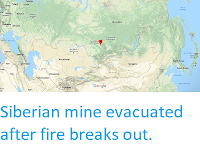A mine in Kemerovo Oblast in southwest Siberia has safely evacuated 128 miners who were working below ground when a rise in carbon monoxide was detected on Sunday 19 December 2021. The sudden increase triggered concerns that a fire might be burning within the mine (coal, which is essentially pure carbon, usually burns to produce carbon dioxide, but when the oxygen supply is limited, as in an underground mine, incomplete combustion can result in the production of the more deadly carbon monoxide). However, the owners of the Ruban Mine have found no evidence of a fire, and now believe the gas was emitted directly from the coal following a rise in temperature within the mine.
Coal is formed when buried organic material, principally wood, in heated and pressurized, forcing off hydrogen and oxygen (i.e. water) and leaving more-or-less pure carbon. Methane is formed by the decay of organic material within the coal. There is typically little pore-space within coal, but the methane can be trapped in a liquid form under pressure. Some countries have started to extract this gas as a fuel in its own right. When this pressure is released suddenly, as by mining activity, then the methane turns back to a gas, expanding rapidly causing, an explosion. This is a bit like the pressure being released on a carbonated drink; the term 'explosion' does not necessarily imply fire in this context, although as methane is flammable this is quite likely.
Coal is also comprised more or less of pure carbon, and therefore reacts freely with oxygen (particularly when in dust form), to create carbon dioxide and (more-deadly) carbon monoxide, while at the same time depleting the supply of oxygen. This means that subterranean coal mines need good ventilation systems, and that fatalities can occur if these break down.
While this incident resulted in no harm, with employees being safely evacuated from a potential threat, which is good practice in mine safety management, the Russian Emergencies Ministry has raised concerns about mine safety in Kemerovo Oblast, following an explosion at the Listvyazhnaya Mine which killed 51 people in November, with one of the mine's owners subsequently being arrested on suspicion of falsifying data on methane emissions within the mine. Kemerovo Oblast was also the location of the worst mining disaster in post-Soviet Russian history, when an explosion at the Ulyanovskaya Mine killed more than 100 people.
See also...







